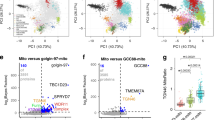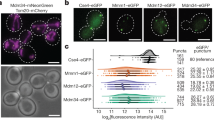Abstract
The Golgi apparatus in animal cells comprises a reticulum of linked stacks in the pericentriolar and often in the juxtanuclear regions of the cell1. The unique architecture of this organelle is thought to depend on the cytoskeleton2 and cytoplasmic matrix proteins3,4—the best characterized being the golgin family of fibrous, coiled-coil proteins and the GRASP family of stacking proteins5,6,7,8,9,10. Here we show that these matrix proteins can be separated from oligosaccharide-modifying enzymes in the Golgi stack without affecting their ability to form a ribbon-like reticulum in the correct location near to the nucleus. Our data suggest that the Golgi is a structural scaffold that can exist independently of, but is normally populated by, the enzyme-containing membranes that modify transiting cargo. This new concept of the Golgi further indicates that the Golgi may be an autonomous organelle rather than one that is in simple dynamic equilibrium with the endoplasmic reticulum.
This is a preview of subscription content, access via your institution
Access options
Subscribe to this journal
Receive 51 print issues and online access
$199.00 per year
only $3.90 per issue
Buy this article
- Purchase on Springer Link
- Instant access to full article PDF
Prices may be subject to local taxes which are calculated during checkout




Similar content being viewed by others
References
Farquhar, M. G. & Palade, G. E. The Golgi-apparatus—100 years of progress and controversy. Trends Cell Biol. 8, 2–10 (1998).
Donaldson, J. G. & Lippincott-Schwartz, J. Sorting and signaling at the Golgi complex. Cell 101, 693–696 (2000).
Dematteis, M. A. & Morrow, J. S. The role of ankyrin and spectrin in membrane-transport and domain formation. Curr. Opin. Cell. Biol. 10, 542–549 (1998).
Linstedt, A. D. Stacking the cisternae. Curr. Biol. 9, R893 –R896 (1999).
Nakamura, N. et al. Characterization of a cis-Golgi matrix protein, GM130. J. Cell Biol. 131, 1715–1726 (1995).
Barr, F. A. A novel Rab6-interacting domain defines a family of Golgi-targeted coiled-coil proteins. Curr. Biol. 9, 381– 384 (1999).
Munro, S. & Nichols, B. J. The GRIP domain—a novel Golgi-targeting domain found in several coiled-coil proteins. Curr. Biol. 9, 377–380 ( 1999).
Shorter, J. et al. GRASP55, a second mammalian GRASP protein involved in the stacking of Golgi cisternae in a cell-free system. EMBO J. 18, 4949–4960 (1999).
Sonnichsen, B. et al. Role for Giantin in docking COPI vesicles to Golgi membranes. J. Cell Biol. 140, 1013– 1021 (1998).
Kjer-Nielsen, L., Teasdale, R. D., van Vliet, C. & Gleeson, P. A. A novel Golgi-localisation domain shared by a class of coiled-coil peripheral membrane proteins. Curr. Biol. 9, 385– 388 (1999).
Rothman, J. E. & Wieland, F. T. Protein sorting by transport vesicles. Science 272, 227– 234 (1996).
Aridor, M., Bannykh, S. I., Rowe, T. & Balch, W. E. Sequential coupling between COPII and COPI vesicle coats in endoplasmic-reticulum to Golgi transport. J. Cell Biol. 131, 875– 893 (1995).
Pepperkok, R., Lowe, M., Burke, B. & Kreis, T. E. Three distinct steps in transport of vesicular stomatitis virus glycoprotein from the ER to the cell surface in vivo with differential sensitivities to GTP gamma S. J. Cell Sci. 111, 1877– 1888 (1998).
Lippincott-Schwartz, J., Yuan, L. C., Bonifacino, J. S. & Klausner, R. D. Rapid redistribution of Golgi proteins into the ER in cells treated with brefeldin A: evidence for membrane cycling from Golgi to ER. Cell 56, 801–813 (1989).
Doms, R. W., Russ, G. & Yewdell, J. W. Brefeldin A redistributes resident and itinerant Golgi proteins to the endoplasmic reticulum. J. Cell Biol. 109, 61–72 (1989).
Sandvig, K., Prydz, K., Hansen, S. H. & van, D. B. Ricin transport in brefeldin A-treated cells: correlation between Golgi structure and toxic effect. J. Cell Biol. 115, 971– 981 (1991).
Hendricks, L. C., McClanahan, S. L., McCaffrey, M., Palade, G. E. & Farquhar, M. G. Golgi proteins persist in the tubulovesicular remnants found in Brefeldin A-treated pancreatic acinar cells. Eur. J. Cell Biol. 58, 202– 213 (1992).
Lippincott-Schwartz, J. et al. Microtubule-dependent retrograde transport of proteins into the ER in the presence of brefeldin A suggests an ER recycling pathway. Cell 60, 821–836 ( 1990).
Shima, D. T., Cabrera-Poch, N., Pepperkok, R. & Warren, G. An ordered inheritance strategy for the Golgi apparatus: visualization of mitotic disassembly reveals a role for the mitotic spindle. J. Cell Biol. 141, 955–966 (1998).
Cole, N. B., Sciaky, N., Marotta, A., Song, J. & Lippincott-Schwartz, J. Golgi dispersal during microtubule disruption—regeneration of Golgi stacks at peripheral endoplasmic-reticulum exit sites. Mol. Biol. Cell 7, 631–650 (1996).
Storrie, B. et al. Recycling of Golgi-resident glycosyltransferases through the ER reveals a novel pathway and provides an explanation for nocodazole-induced Golgi scattering. J. Cell Biol. 143, 1505 –1521 (1998).
Girod, A. et al. Evidence for a COP-I-independent transport route from the Golgi complex to the endoplasmic reticulum. Nature Cell Biol. 1, 423–430 (1999).
Lippincott-Schwartz, J. et al. Brefeldin A's effects on endosomes, lysosomes, and the TGN suggest a general mechanism for regulating organelle structure and membrane traffic. Cell 67, 601–616 (1991).
Reaves, B. & Banting, G. Perturbation of the morphology of the trans-Golgi network following Brefeldin A treatment: redistribution of a TGN-specific integral membrane protein, TGN38. J. Cell Biol. 116, 85–94 ( 1992).
Cluett, E. B. & Brown, W. J. Adhesion of Golgi cisternae by proteinaceous interactions: intercisternal bridges as putative adhesive structures. J. Cell Sci. 103, 773– 784 (1992).
Nilsson, T. et al. Kin recognition between medial Golgi enzymes in HeLa cells. EMBO J. 13, 562–574 (1994).
Zaal, K. J. et al. Golgi membranes are absorbed into and reemerge from the ER during mitosis. Cell 99, 589– 601 (1999).
Rowe, T. & Balch, W. E. Expression and purification of mammalian Sar1. Methods Enzymol. 257, 49 –53 (1995).
Seemann, J., Jokitalo, E. J. & Warren, G. The role of the tethering proteins p115 and GM130 in transport through the Golgi apparatus in vivo. Mol. Biol. Cell 11, 635–645 ( 2000).
Acknowledgements
We would like to thank J. Shorter for his comments. This work was funded by the NIH and J.S. was supported by a postdoctoral fellowship from the Deutsche Forschungsgemeinschaft.
Author information
Authors and Affiliations
Corresponding author
Rights and permissions
About this article
Cite this article
Seemann, J., Jokitalo, E., Pypaert, M. et al. Matrix proteins can generate the higher order architecture of the Golgi apparatus. Nature 407, 1022–1026 (2000). https://doi.org/10.1038/35039538
Received:
Accepted:
Issue Date:
DOI: https://doi.org/10.1038/35039538
This article is cited by
-
Cdk1 protects against oxygen-glucose deprivation and reperfusion-induced Golgi fragmentation and apoptosis through mediating GM130 phosphorylation
Journal of Molecular Histology (2023)
-
Transcriptional responses in Ecklonia cava to short-term exposure to polycyclic aromatic hydrocarbons
Molecular & Cellular Toxicology (2022)
-
A signal motif retains Arabidopsis ER-α-mannosidase I in the cis-Golgi and prevents enhanced glycoprotein ERAD
Nature Communications (2019)
-
Synaptotagmin 17 controls neurite outgrowth and synaptic physiology via distinct cellular pathways
Nature Communications (2019)
-
The role of Rab6a and phosphorylation of non-muscle myosin IIA tailpiece in alcohol-induced Golgi disorganization
Scientific Reports (2016)
Comments
By submitting a comment you agree to abide by our Terms and Community Guidelines. If you find something abusive or that does not comply with our terms or guidelines please flag it as inappropriate.



